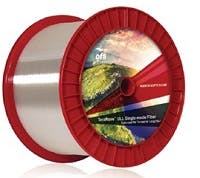TeraWave™ ULL Optical Fiber brings submarine fiber technology into terrestrial fiber, making it possible to cable a fiber with 50% higher effective area than standard G.652.D fiber. Silica core technology enables the ultra-low loss capability.
Owing to its ultra-low nominal loss of 0.168 dB/km and its large effective area of 125 sq. microns, TeraWave ULL ITU-T G.654.B Fiber allows 8-QAM format (150 Gbps) coherent wavelengths to travel 4800 km with one systems house's platform, as an example. This distance is 65% longer than legacy G.652 fiber frequently found in the field today. For simple, point-to-point data center interconnect applications in metro regions, the systems vendor showed that TeraWave ULL Fiber can support 16QAM (200 Gbps) formats at distances greater than 250 km with only EDFA at the end terminals, which is 37% greater than legacy G.652 fiber.
Judge's comment: "The development of the TeraWave ULL Single-Mode Optical Fiber is marked by both engineering and ingenuity. Applying submarine fiber technology to a terrestrial fiber, to meet a current and growing connectivity challenge, shows thoughtful innovation. Achieving a 50%-higher effective area than existing technology is an engineering feat. Combining those two characteristics to lower the cost-per-bit of a lighted fiber, by eliminating the need for regeneration, is a noteworthy accomplishment."
Click here to return to the 2017 Lightwave Innovation Reviews page.
Sponsored Recommendations
Sponsored Recommendations
March 25, 2025
March 12, 2025
Oct. 29, 2024
March 10, 2025
New
New

